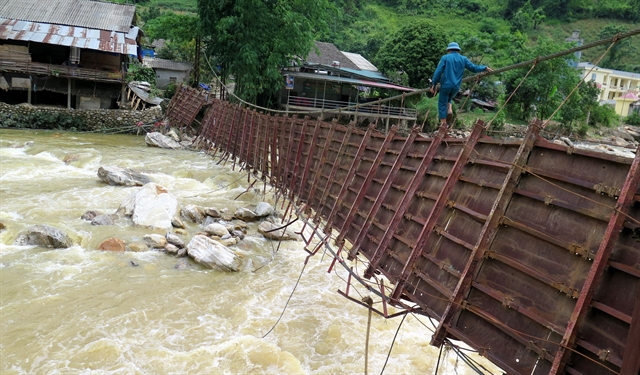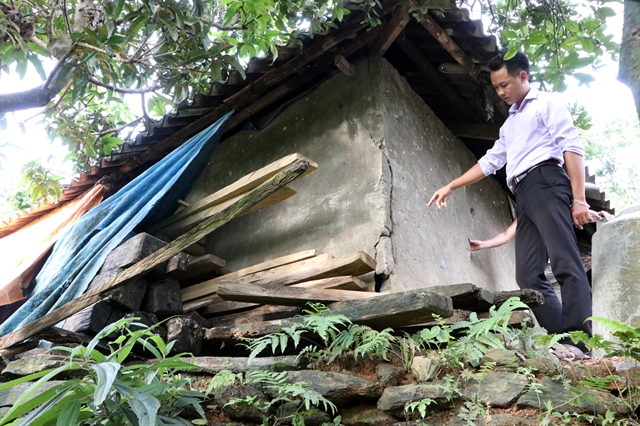 Society
Society


|
| People living next to the stream in Hồ Village, Sa Pa, Lào Cai Province are at heightened risk of losing their homes to landslides and flash floods. — VNA/VNS Photo Hương Thu |
HÀ NỘI — Flash floods battered northern mountainous area in late June, sweeping away Lù Văn Vé’s house and all of his belongings.
More than one month later, Vé, in his late 50s, told Vietnam News Agency that seven members of his family are still staying at a neighbour's house while they wait for a new place to live.
Nà Hừ Village in Mường Tè District, Lai Châu Province, where Vé lives, houses 230 families near Nậm Bum Stream in an area highly prone to landslides and flash floods.
Chairman of the district’s People’s Committee Mai Văn Thạch said the village is densely populated. There are not enough land lots for families living in danger areas to relocate.
“The district has about 150 households in urgent need of relocation," he said. "Due to budget and land fund difficulties, the relocation plan has been delayed."
Last year’s torrential rains and flash floods in the province killed 25 people, left 14 others missing and collapsed 134 houses. Nearly 400 households were forced to relocate.
According to Hà Văn Um, director of Lai Châu Province’s Department of Agriculture and Rural Development, there are now 300 households in the province in need of relocation. Due to budget difficulties, Um said, “relocating all these families at the same time is not an easy task”.
Whenever it rains for a few days in a row, Dương Ngọc Lâm and his family in Nà Đứa Commune, Tuyên Quang Province's Na Hang District have to move to a neighbour’s house in a safe area in case of landslides.
Three years ago, cracks started to appear inside Lâm’s house after repeated torrential rains and flash floods.
“The cracks in the village stretch hundreds of metres," he said. "During the rainy season, new cracks 15 to 20cm length and a metre deep appear.”
Lâm's family is just one of 138 families in the commune in need of relocation.
Although a plan to move the families is ready on paper, district authorities have been unable to secure the huge amount of funding needed.
In the northern mountainous provinces of Lai Châu, Yên Bái, Lào Cai and Tuyên Quang, which are frequently battered by natural disasters and have the highest numbers of victims, there are thousands of households in areas at high risk of landslides and flash floods in urgent need of safe spaces to live.
But once again, a lack of funds and open space has delayed their relocation, leaving residents on the brink of disaster. Residents have no choice but to wait patiently for new houses.
Unstable resettlement
Those lucky enough to be resettled appreciate their newfound security, but their livelihoods are not always improved.
About 30 Dao ethnic minority families in Phia Chang Hamlet, Sơn Phú Commune, Tuyên Quang’s Na Hang District moved to Thuôm Kiệu Resettlement Area in 2014.
Đặng Thị Xuân, one of the people who resettled, said: “My family moved to the resettlement area hoping for a better life. But life has become tougher without having land to cultivate.”
“Every day, I have to go to the forest searching for bamboo shoots and herbal plants and sell them for about VNĐ50,000 (US$2.1) to buy rice for the whole family," she said. "But this is not enough for us to live on."
Phùng Xuân Học, head of Nà Mu Hamlet, said that before families moved to the new area, just a few of them were classified as poor. But now, because they lack land to grow food, 27 out of the 30 families are classified as poor or near poor households. Some families have left the resettlement area to move close to a lake and raise fish.

|
| A crack that appeared on the side of a house in Hồng Thu Mán Village, Lai Châu Province's Phong Thổ District last year. VNA/VNS Photo Việt Hoàng |
In Van Hồ Village in Phìn Ngan Commune, Bát Xát District, Lào Cai Province, 19 families were relocated far from their fields, affecting their incomes. Many farmers have had to stay in tents by their fields to take care of their crops.
Tẩn Láo Tả, chairman of the commune’s People’s Committee, said the local authorities are assisting residents in finding new sources of income not reliant on growing crops.
In Vàng Mai Chải Commune, Phong Thổ District, Lai Châu Province, residents are lucky to both have a safe place to live and be able to maintain their production. But they lack access to electricity and indoor plumbing.
Ready to respond
Some communities have taken matters into their own hands. Despite the limited local budget, many families in Lai Châu Province's Sìn Hồ and Phong Thổ districts moved to safer places without waiting for authorities.
The National Centre for Hydro-meteorological Forecasting predicted that this year there will be a lot of torrential rains, causing flash floods and landslides in the northern mountainous region.
The Government's strategy to reduce the risks associated with natural disasters this year stems from local communities, meaning people play a key role in minimising losses.
Vice chairman of Yên Bái Province’s People’s Committee Nguyễn Văn Khánh proposed the Government, the Steering Committee on Natural Disaster Prevention and Control and relevant agencies study solutions to reduce natural disasters, flash floods and landslides in the northern mountainous region.
He said he expected the Ministry of Natural Resources and Environment to increase the accuracy of flash flood and landslide risk maps to help direct natural disaster prevention work at the local level.
He proposed the Government equip northern mountainous provinces with natural disaster forecasting and early warning devices, and allocate funds to repair damaged rivers, streams, transport infrastructure and irrigation words. — VNS




